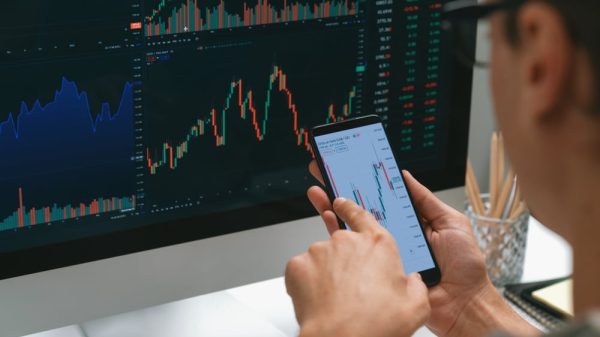Buy side liquidity and sell side liquidity – explained
Key takeaways:
Understanding Liquidity: Grasping Buy side and Sell side Liquidity is vital for financial success.
Informed Trading: Traders need to consider key factors such as liquidity, spreads, volume, and stops when making decisions.
Liquidity’s Significance: Liquidity ensures smooth large trades, benefiting both buyers and sellers.
Fast Market Navigation: In dynamic markets, monitoring liquidity and acknowledging institutional investors boost traders’ confidence and success.
Have you ever thought about how to buy side liquidity and sell side liquidity as a true professional? Are you also aware of how experienced experts in this field of finance do it impeccably and effectively? And how to learn such a thing nowadays?
It’s crucial to note that buy-side liquidity refers to a certain level on the chart. In it, short sellers have their particular stops positioned.
Conversely, sell-side liquidity represents a certain level on the chart for long-biased traders who will set their stops there. To understand this material and become an expert, let’s begin with the basic explanation, shall we?
What is Buy side and sell side liquidity?
Buy-side and sell side liquidity help find market makers and liquidity providers in real-time trading. Purchasing liquidity designates a point on the chart where individuals’ short-selling will establish their stop orders.
Conversely, selling liquidity refers to a point on the chart where long-term buyers will set their stop orders. Market makers and liquidity providers gather in the order book depth. Traders frequently make incorrect predictions in areas where they find these points.
What do these skilled participants aim to achieve?
Skilled participants strategically adjust their positions near certain levels. They consider bid-ask spread, trading volume, and stop orders.
They absorb all available liquidity, influencing market dynamics and ensuring profit-making.
Understanding Buy-side and Sell-side Liquidity
Market liquidity refers to the ability of a market to effectively handle large buy and sell orders. It measures the extent to which the actual trade price aligns with the expected price, despite the size of the order.
This ensures that investors, especially big ones, can execute significant trades with minimal slippage, avoiding substantial price fluctuations.
What do financial experts use to accomplish this?
Financial experts use buy side liquidity to accomplish this. Accessing it is possible through limit orders, which entail setting a specific price for buying or selling.
Market orders, on the other hand, involve buying or selling at the current market price. Sell-side liquidity allows sellers to sell securities in large amounts without impacting prices. It gives flexibility for setting specific selling prices or selling at the current market price.
How to utilize it?
If you want to use buy side and sell side liquidity, here’s what you need to know.
Reversals in Volatile Markets
In fast and volatile markets, quick position closures by traders lead to price reversals in the opposite direction.
Traders should carefully monitor price actions to confirm potential reversals near these critical levels.
Extensionin Trending Markets
Liquidity is crucial for sustaining trends in the stock market. Traders can look for setups supporting the ongoing trend when the price exceeds important liquidity levels.
These levels should also maintain the same order flow structure.
Inducement Strategies for Market Participants
Experienced market participants, including institutional investors, may strategically adjust prices to access liquidity when necessary. Inducement strategies find advantageous liquidity levels for selling securities on both the buying and selling sides.
To learn more about financial tactics and strategies, and find valuable editorial content, check out our financial resources.
Market Liquidity: Advantages and Drawbacks
Market liquidity is like swimming in shallow waters – it can be challenging, and excessive liquidity can cause problems.
Conversely, skilled swimmers or those well-prepared can enjoy deep waters. In the financial realm, market liquidity operates similarly—too much or too little can pose issues.
Liquidity’s Economic Role: A Simple Explanation
In economics, liquidity is the ease of trading assets at low costs. It involves the ability to quickly enter or exit a trade, which impacts price movement.
Easy transactions are important when a lot of money is available, and interest rates are low. This helps with buying and selling assets like stocks.
Having sufficient funds is essential for economic growth and price increases. This benefits investors in their stock trading activities.
Central Banks’ Liquidity Measures
Central banks, like India’s RBI, use various methods to ensure sufficient money availability, particularly during times of crisis.
These methods include bond buybacks and Open Market Operations.
Drawbacks of Excessive Liquidity
Excessive money can increase prices as demand rises, leading to inflation and economic bubbles.
Market Turmoil and Central Banks
When central banks reduce liquidity during economic recovery, these bubbles burst, causing market fluctuation and significant investment losses, maintaining doubt.
Navigating Liquidity: Wise Choices
Liquidity’s abundance or scarcity can yield both positive and negative outcomes. Smart investors choose portfolios that leverage liquidity’s advantages.
They are cautious about several negative aspects. These include stop losses, retail investors, price changes, and the main roles of buyers and sellers in the market.
Regulatory Role of Financial Review Boards
Financial review boards oversee and regulate market liquidity, ensuring a fair marketplace for everyone involved.
To delve deeper into this subject and related topics, learn about our editorial content to gain a better understanding.
Why to use buy side liquidity?
Buy-side liquidity serves two crucial purposes in the market:
Targeting Market Highs
Investors see market highs as places to buy. Banks and financial institutions pay attention to these peaks.
They strategically leverage the collected buy orders at these highs to drive prices upward. They create good conditions for buying and selling assets, making the most of price changes to get more money.
Buy-side liquidity thus acts as a strategic tool to exploit market opportunities and enhance trading outcomes.
Why using it?
Using buy-side liquidity like this helps BFIs and smart traders improve their investment strategies and make more money.
It enables them to identify key market levels and deploy capital efficiently, contributing to better overall financial performance.
By using buy-side liquidity to aim for market highs, they can have an advantage in understanding financial markets.
Bottom line
Understanding and utilizing Buy-side and Sell-side Liquidity is fundamental for traders and investors in financial markets. Liquidity is pivotal for seamless trade execution, benefiting both buyers and sellers.
Recognizing supply and demand dynamics and acknowledging the influence of institutional investors enhances traders’ confidence, particularly in hard-to-read markets. To gain deeper insights into market dynamics and strategies, explore our financial and editorial content.
This information is helpful for big investors. It shows how liquidity affects short-term and uncertain markets, making it easier to buy or sell a stock. Consider learning about our financial resources to further enhance your understanding.
The post Buy side liquidity and sell side liquidity – explained appeared first on FinanceBrokerage.


































